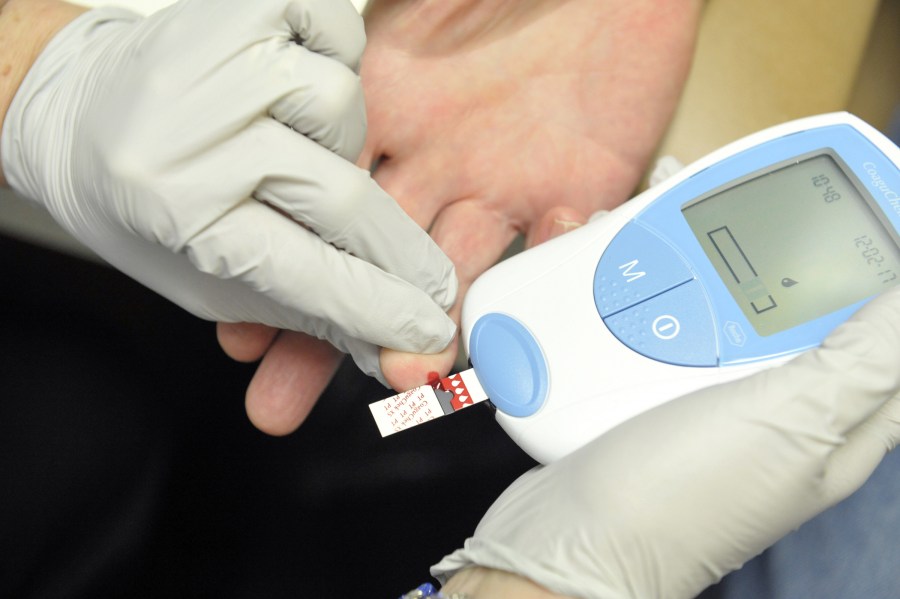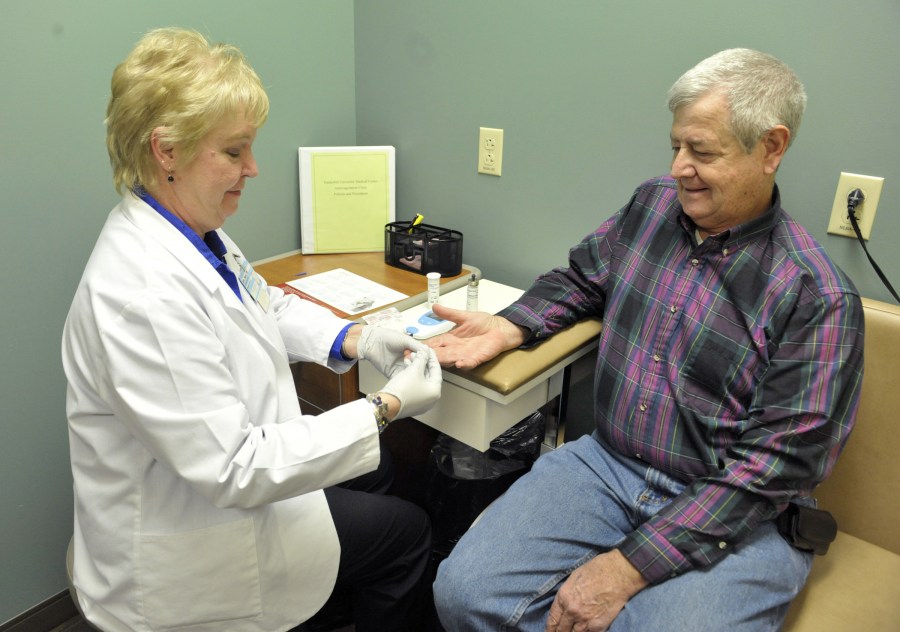
Vanderbilt Heart at One Hundred Oaks is now offering point-of-care coagulation testing through a finger stick, above, rather than a blood draw. (photo by Joe Howell)
Anticoagulation Clinic hits stride with new services
Alongside its telemedicine services, the Anticoagulation Clinic recently introduced point-of-care coagulation testing at Vanderbilt Heart at One Hundred Oaks.
Here, patients get a finger stick instead of a blood draw, and their medication dose can be adjusted on the spot by a coagulation nurse.
The clinic will soon add point-of-care testing at Vanderbilt Heart in the Williamson Tower in Franklin, Tenn.

Wendell Conner works with Ann Hace, R.N., to have his medication dose adjusted at the Anticoagulation Clinic. (photo by Joe Howell).
“Patients tell us they greatly appreciate this new service,” said Clinic Manager Karla Davis, R.N., MSN, MHA.
The clinic itself is located in the Green Hills Office Building, where 16 coagulation nurses and one pharmacist communicate regularly by telephone with patients who take the anticoagulation drug warfarin. The patients are spread among three states.
Since June 2010, the clinic has increased enrollment from 2,305 patients to 3,291, and has helped increase rates of in-range blood-clotting values across this population from 79 percent to 81 percent.
Patients seen in many different surgical and medical specialty clinics take warfarin to help prevent unwanted blood clotting inside the circulatory system (thrombosis) and associated blood vessel blockage (embolism).
Dosing of warfarin is somewhat unpredictable because sensitivity to the drug varies considerably and certain foods and common medications interact with it.
Vanderbilt clinical information systems aid outpatient anticoagulation management. As patients’ periodic coagulation test results are faxed in from far-flung clinical laboratories, nurses enter them into the electronic record.
Each nurse at the clinic follows approximately 200 patients. A computer display, or dashboard, presents a table where rows of patients intersect columns representing periodic test results, allowing nurses to review the status of their patients at a glance: abnormal results are highlighted in yellow or red, with yellow indicating a below-range result (and associated clotting risk); and red indicating an above-range result (and associated bleeding risk); empty cells indicating missing overdue results are also highlighted in red.
According to national guidelines for anticoagulation, certain patients need more frequent testing, and the desired range of test result values is different for some patients. Such variances are noted in each patient’s electronic record and the dashboard takes them into account.
Following a protocol derived from the national guidelines, the clinic’s nurses change doses for patients based on test results. For patients who may have trouble sticking to their testing regimen, nurses provide information on mobile testing services or testing services for lower income groups.
According to Davis, so far warfarin use hasn’t significantly changed with the availability of a new alternative, an oral anticoagulant called dabigatran (trade name Pradaxa), which doesn’t require periodic testing.
To refer patients to the clinic, use the Anticoagulation Clinic Enrollment Form in StarPanel.













